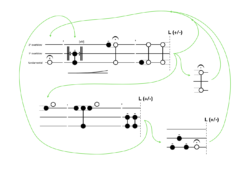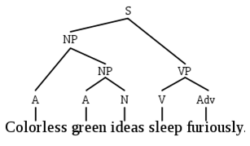register notation - first attempt

This is the first attempt in the project to do two things (explicitly in notation).
- Under-determine the specific musical material: the notation specifies no pitches or fingerings.
- Create recursive structures that can be dependent on material-agency.
The first point was always a goal of the project, to flip the normal approach to clarinet multiphonics (and general clarinet writing) by avoiding specifying pitches or fingerings, so that harmony is an emergent property. This is achieved here by notating a generalisable aspect of clarinet technique and using that to manipulate any given fingering. The three lines in the notation are for the three clarinet registers—chalumeau (E3–A#4), clarino (B4–C6), and altissimo(C#6 and above)—which all require different embouchure. Clarinettists have a clear sense of different embouchure techniques to playing single pitches in each register. When playing multiphonics these techniques can be applied (with nuanced variation specific to each fingering) to either isolate specific registers of that multiphonic, or to find inbetween positions that allow multiphonics connecting different registers.
The notation begins with the assumption that any fingering on the clarinet can produce isolated pitches in each register, and also multiphonics that include any or all of these pitches.* In practice, the former is almost always true since any fingering can be overblown to produce harmonics, but underblowing (producing pitches lower than those the fingering is 'normally' used for) is not always successful. E.g. on the B4 fingering at the bottom of the clarino register it's extremely difficult to underblow to produce a chalumeau pitch, as you go up the clarino register this gets easier, while in altissimo fingerings the opposite is the problem, with chalumeau pitches being usually straightforward but clarino pitches are less predictable. With multiphonics in practice the same is largely true. Multiphonics are often stable across two registers but less so across all three. Chalumeau connects easily with clarino or with altissimo, though some fingerings prefer one or the other. Some rare fingerings connect clarino and altissimo but not chalumeau.
The intention with this notation—at least when it was conceived—was that this was for fingerings with known stable multiphonics, that this notation could then manipulate these. Black noteheads are short, white noteheads are long. Horizontal dotted-lines act as slurs to connect behaviours, and implying a phrasing contour: which will be variable since different fingerings have different levels of resistance or stubborn-ness in sounding. Dynamics are not included since these are often dictated by the multiphonic, but accents are included (and can be nuanced considerably), and also a hairpin indicating not volume per se but intensity or effort. As can be seen on the second system, it's also possible to push the player into less-familiar territory using noteheads off the lines, which is more realistic when used to stretch higher into the altissimo. While not every fingering can produce the required behaviours, part of the point here is that the notation acts as a kind of exploratory technique on the fingering by exposing the topology of any given fingering. Part of the recursive nature of these pieces is that different fingerings can run through the same set of gestures and result in both different sounds and also different pathways.
Which leads to the second objective listed at the start of this, that of recursive structures. The most important aspect of this notation for me is the breaks, the vertical dashes that indicate a non-specific change to the fingering while it's being played. In this draft the 'L(+/-)' indicated the addition or removal of a 'load' key** but in practice I've been changing keys arbitrarily. By interrupting the multiphonic several possibilities emerge that can bring material agency to the fore. If the embouchure position is kept the same and the player doesn't immediately correct it to fit the new fingering, the multiphonic will likely break by collapsing into a single pitch; which could be in any register but is most likely to be one of the two registers in use pre-break. Equally, the player could change embouchure as they change fingering, which would maintain the quality of multiphonic from before the break. The notation above presents all three of these possibilities as different paths.
Which path to chose, and what of backup plans? The question of human and material agencies here is partly one of intention. The player can choose a risky strategy of arbitrarily changing the fingering, not altering embouchure to mitigate the destabilisation, and seeing what happens, in which case they follow what path the material agency dictates. The player can test the paths in rehearsal to know how to respond to the new fingerings, thus constructing their own path through the piece. There is still the possibility of contingencies here should the pre-written path not go to plan, but the notation still offers a fallback position. What this draft does not do is take every possibility into account, so there are probably unforeseen possibilities that in this draft don't have a path. Or maybe not all paths need to be notated. We will see.
Next steps. My follow-up from this is the interesting possibilities around the decoupling of fingering-change and embouchure-change: i.e. keeping embouchure the same while fingers are changed, or vice versa. The decoupling itself offers a new set of possibilities for the notation by extending '(+/-)' to balance changing keys with also changing or maintaining of embouchure position. Also, and in line with original conception, the notation can be extended to specify valence and direction to the fingering changes. Rather than simply 'change to anything', the notation could indicate hierarchy of fingerings analogous to the forking-path metaphor by indicating main pathway and branches of decreasing import (there's something Chomskyan about this***). Without specifying the fingering itself, something like a numbering system could indicate the initial fingering and subsequent changes. Even more interesting would be a responsive system that allowed for notational functions like 'return to the fingering that produced the most (or least) striking change in harmony', or 'alternate fingerings that produce on slight timbral/microtonal alterations', etc.
* Also, the image above labels the lines as 'fundamental', '1st overblow', '2nd overblow' but this has now been superceded by simply using the three register names: for now at least, the jury is still out on this...
** Thomas Bergeron—in his Scalar Model for saxophone multiphonics—describes load keys as the closing of holes below the current end of the air column, which has the tendency to lower the overall pitch (though sometimes only by microtonal amounts). He contrast this with vent keys which open holes above the column, producing often complex effects on timbre and pitch, (more than simply raising pitch overall).
*** Re. Noam Chomsky's hierarchical grammar trees, subsequently used in music theory by Lerdahl and Jackendoff.

Fig.1: Chomsky grammar tree
